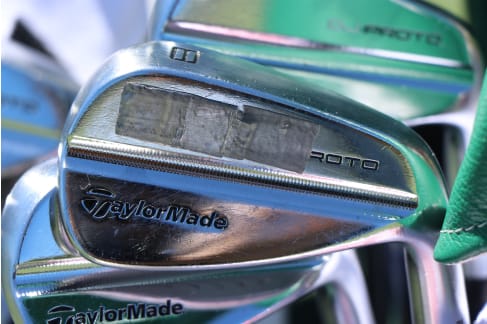Lead weight is the way to go to get the right swing weight. Another option would be finding a lightweight putter grip to increase the swing weight. Golfworks sells rubber coated tungsten squares that might be more visually appealing on top compared to lead tape but that depends on your preference. The new Swing Science FC-ONE B1 putter has adjustability as it’s middle name. With a removable sole plate that has room to add up to six standard weight plugs. It starts at 330 grams unshafted and can be pushed to 364 grams unshafted with all the weight ports filled. In simple terms the moment of inertia is the measure of a putter's resistance to twisting on off-centre hits. The greater the moment of inertia, the less the putter blade rotation and loss of energy. The way to increase the MOI of a putter is to move weight away from the centre of gravity (CG). Lighter = Subtracting 10 total grams of head weight from Standard, which takes away 5 swingweight points. Heavier = Adding 10 total grams additional head weight than Standard, which adds 5 swingweight points. Extra Heavy = Adding 20 total grams additional head weight than Standard, which adds 10 swingweight points.
Home | About | About this Site | Contact | Site Search
An acronym for Moment of Inertia.

Putter Swing Weight Chart
The Moment of Inertia (MOI) of a putter is a measurement of its resistance to twisting on off-centre hits. The greater the figure, the more stable your putter will be. |
Techno-talk
It is the techno-talk manufacturers use to promote their putters. In simple terms the moment of inertia is the measure of a putter's resistance to twisting on off-centre hits. The greater the moment of inertia, the less the putter blade rotation and loss of energy.
The way to increase the MOI of a putter is to move weight away from the centre of gravity (CG). In other words you redistribute the weight away from its balance point.
Putter Head Weight
Hanger Test
DaveTutelman gives the example of two identicallyweighted coat hangers suspended by a piece of string. If you tap the centre ofeach hanger it will swing back and forth, but not twist.
However, tap the end of each hanger and the hanger with theweights close to the centre of gravity will rotate faster than the hanger withthe weights spread apart.
Although both hangers have the same mass,their weight distribution is different, and this affects their moment ofinertia.
Ping Anser Putter
In 1966 Karsten Solheim used this principle of physics to create what became known as the Ping Anser putter.
By taking away the mass at the centre of the putter through a cavity back and redistributing it at the heel and toe of the putter, he improved the playability of his putter.
MOI Bandwagon
Other manufacturers have joined the MOI bandwagon either by copying Solheim's design or with big-headed mallet putters with extreme weighting away from the centre of gravity.
Bobby Grace Putter Design |
MacGregor Golf produced an elongated putter, the Response ZT 615, which was used by Jack Nicklaus to win the 1986 Masters.
Increasing the heel to toe length helps stabilise a putter at impact in much the same way as a tightrope walker uses a long balancing pole.
Sweetspot Contact
The Moment of Inertia of a putter would be irrelevant if golfers were capable of consistently contacting the ball on the putter head's sweetspot. Because they can't, the effect of off-centre hits can be minimised through design.
However, whatever the manufacturers say, you can't enlarge the sweetspot - you can only enlarge the area of forgiveness. How significant this is for distance and directional control is a matter of opinion.
Scatter Pattern

Scatter of Hits |
Frank Werner and Richard Greig in their book How Golf Clubs Really Work and How to Optimise Their Designs concluded that the scatter of hits on the face of the putter (pattern error) for a typical golfer have a surprisingly small effect on most putts.
Far more important were errors in alignment angle and squaring the putterface to the target.
Summing UP
So what does this all mean to you? In all probability you are more likely to miss putts for reasons other than the moment of inertia of your putter.
Besides weekend golfers wouldn't have a clue what the MOI of their putter is, or even what moment of inertia means.
If you putt with a recognised make and model of putter that has been custom-fitted for you, your focus for improvement is best directed to working on the different skills of putting.
A change to another putter based on its comparative moment of inertia is probably not warranted.
Image Source
1 = www.bobbygraceputters.com
2 = Adapted Drawing from How Golf Clubs Really Work and How to Optimise Their Designs